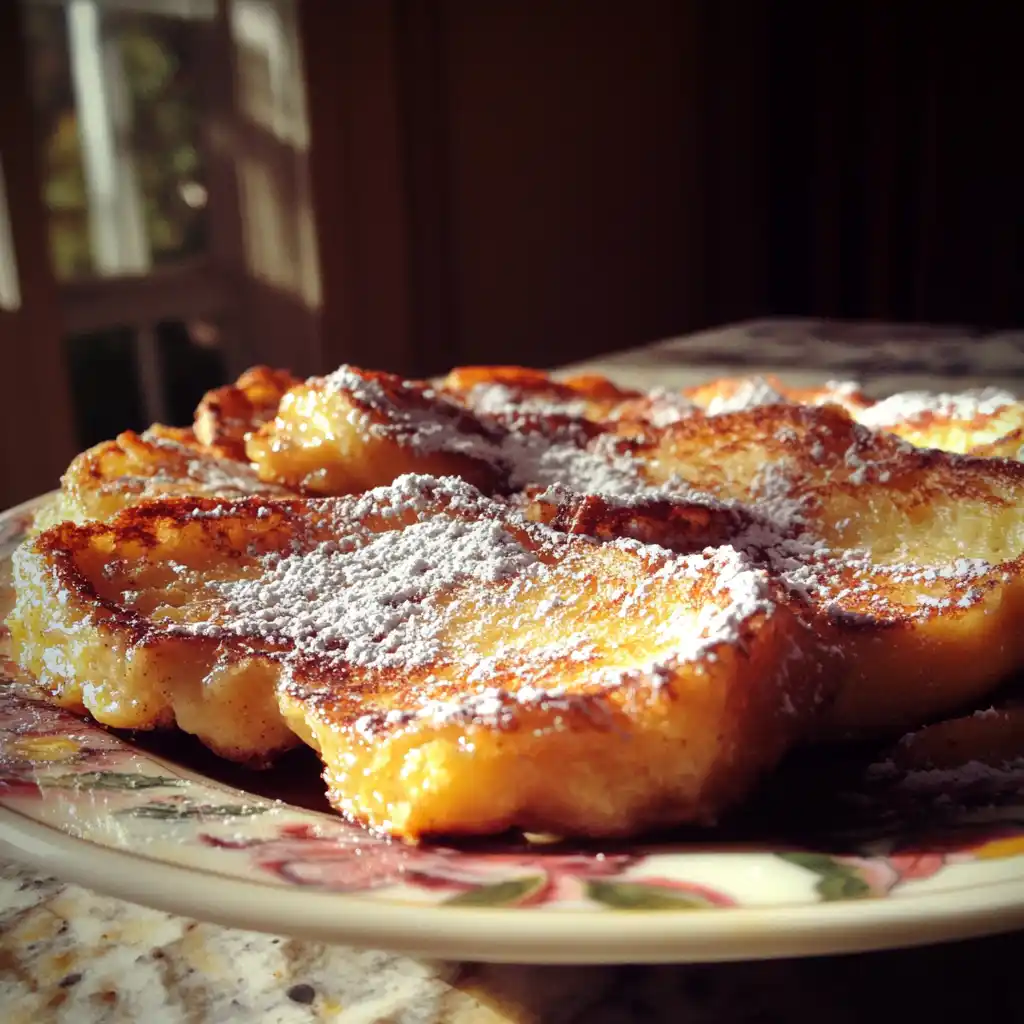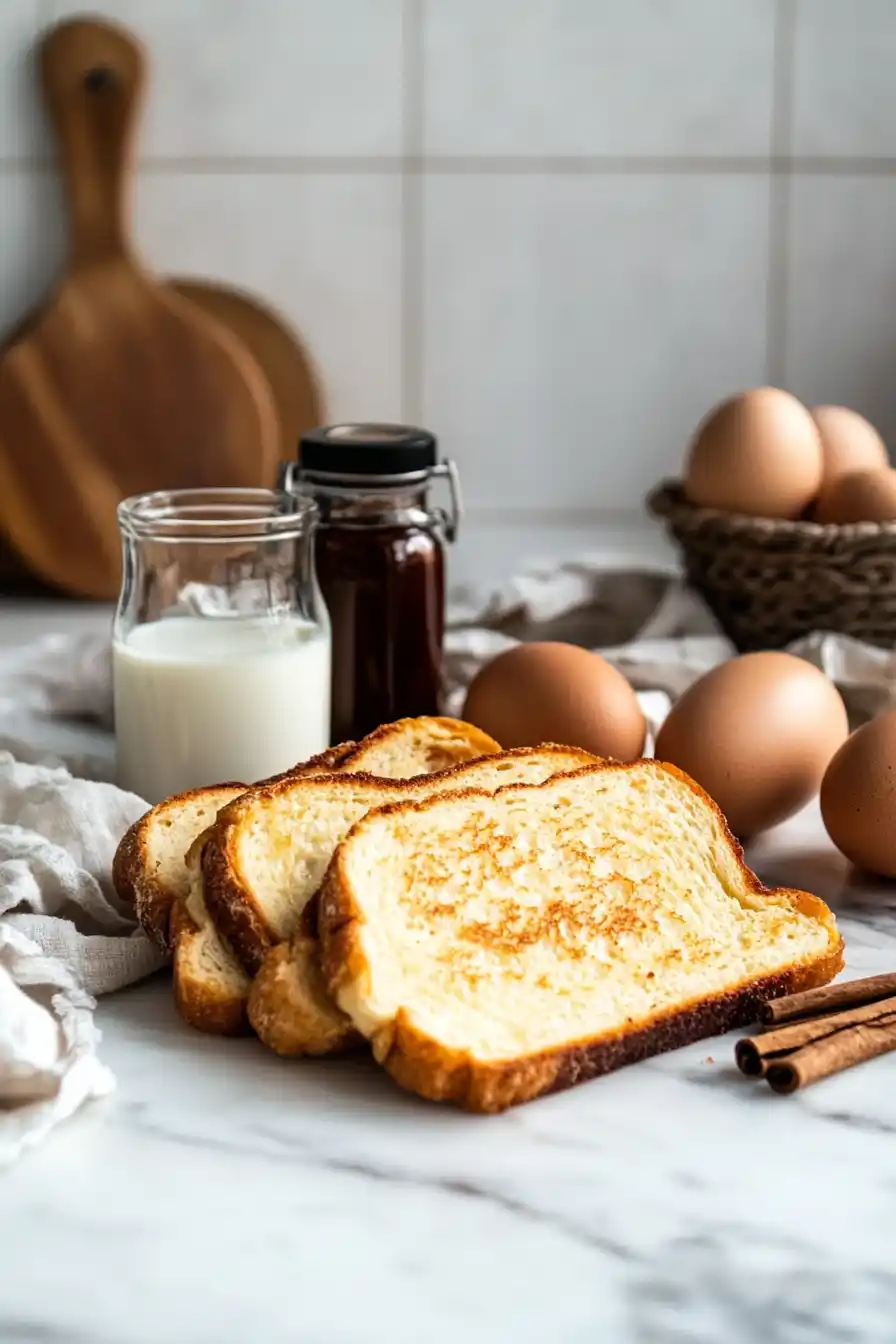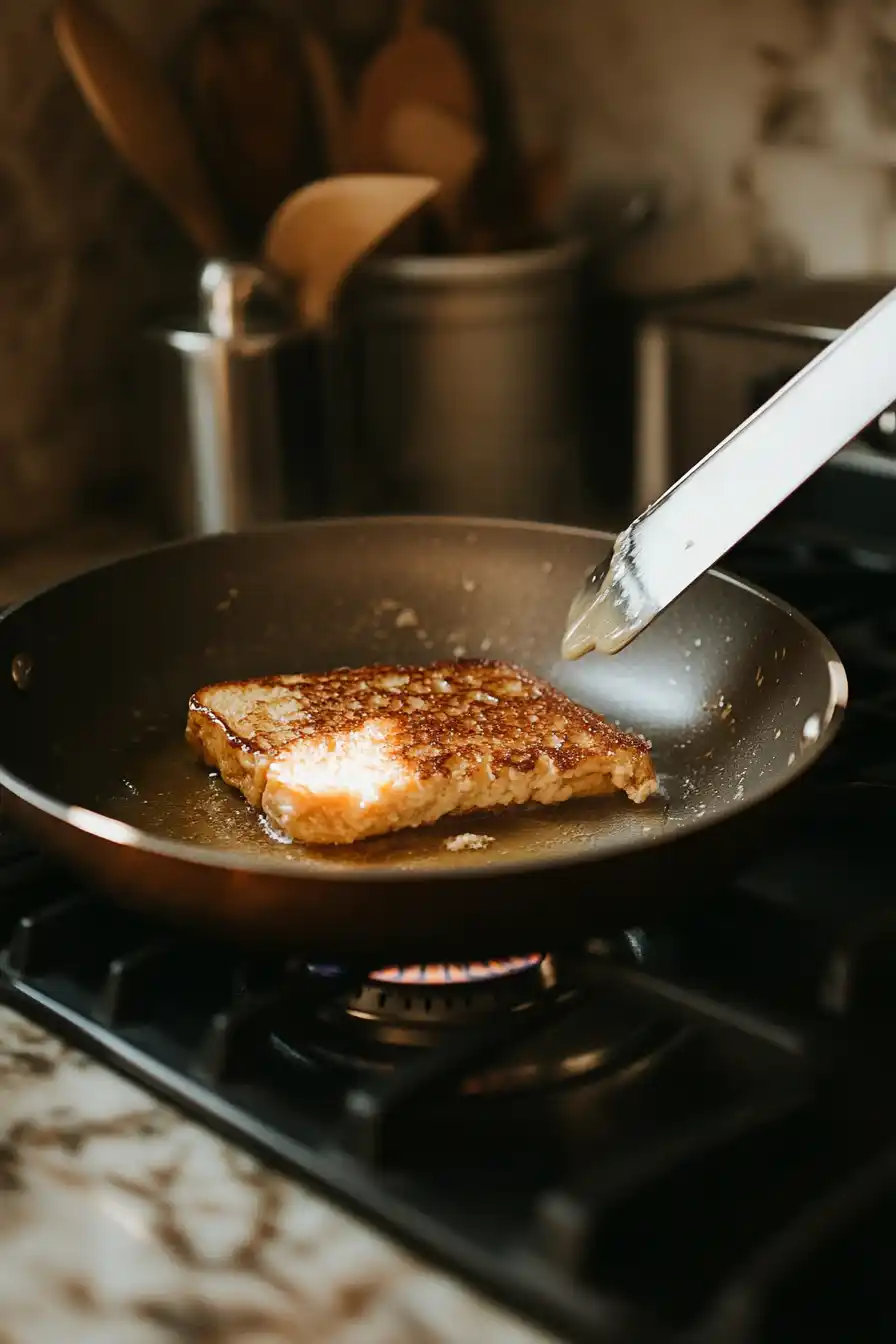Last updated on: February 8, 2025
French toast is one of the simplest yet most delightful breakfast dishes. But have you ever ended up with a soggy, bland, or overly eggy slice? You’re not alone! Many people make small but crucial mistakes that ruin their French toast. In this guide, we’ll uncover the biggest mistake, how to fix it, and expert tips for achieving the perfect golden-brown, crispy French toast every time.

What is the Most Common Mistake in Making French Toast?
Why Getting the Perfect Texture Matters
The best French toast is crispy on the outside, soft but not soggy on the inside, and infused with a delicate, slightly sweet custard flavor. Unfortunately, many people end up with limp, overly wet slices that taste more like scrambled eggs on bread. But why does this happen?
The key to perfect French toast lies in the balance of ingredients, the type of bread, and the cooking technique. A small mistake—like choosing the wrong bread or soaking it for too long—can completely change the outcome.
“A great French toast should be crisp on the outside and soft but structured inside. The right ingredients and technique make all the difference.”
If you’re looking for a delicious variation, check out this Cinnamon Roll French Toast Recipe for a rich, indulgent twist.
The #1 Mistake: Using the Wrong Bread
If your French toast turns out soggy, the first thing to check is your bread choice. Most people grab whatever they have on hand—often soft sandwich bread or anything too thin and airy. Unfortunately, these bread types absorb too much custard, leading to an overly wet center and a lack of structure.
Here’s why using the wrong bread is the most common and disastrous mistake:
- Soft bread absorbs too much liquid – It soaks up the egg mixture too quickly, making it impossible to cook evenly.
- Thin slices cook too fast – This prevents the custard from setting properly, leading to a raw or soggy center.
- Low-quality bread falls apart – Some commercial bread varieties are too processed and don’t hold up during soaking and frying.
For a sturdier alternative, consider using brioche, challah, or a thick French baguette. If you love thick, rich breakfasts, you might also enjoy this Brioche French Toast Casserole recipe for a make-ahead twist on this classic dish.
How Choosing the Right Bread Prevents Soggy Results
To achieve the perfect texture, choose a sturdy, slightly stale bread that can soak up the custard without falling apart. The best options include:
- Brioche – A rich, slightly sweet bread that holds its shape beautifully.
- Challah – Soft yet sturdy, with a light sweetness that enhances the flavor.
- French Baguette – When sliced thick, it creates a crispy outer crust with a soft center.
A simple trick is to leave your bread out overnight to dry slightly. Stale bread absorbs custard more evenly and prevents excess moisture buildup. If your bread is fresh, lightly toast it before soaking to achieve the same effect.
“Using the right bread transforms French toast from soggy and bland to golden, crispy, and flavorful.”
Choosing the Right Bread for Perfect French Toast

Why Stale Bread Works Best
If you’ve ever wondered why restaurant-style French toast is superior to homemade versions, the secret often lies in the bread. Fresh, soft bread may seem like a great option, but it’s actually one of the biggest culprits behind soggy French toast.
Stale bread, on the other hand, is drier and more structured, allowing it to absorb the custard evenly without turning into a mushy mess. When you soak fresh bread in the egg mixture, it tends to absorb too much liquid too quickly, leading to an undercooked, wet center.
Here’s why stale bread is the best choice:
- Less moisture – Dry bread absorbs liquid gradually, preventing oversaturation.
- Better texture – The slight firmness keeps the inside soft but structured while the outside crisps up beautifully.
- Even cooking – Since stale bread doesn’t get too wet, it allows the custard to cook through properly.
If you don’t have stale bread, you can quickly dry out fresh slices by placing them in a warm oven at 275°F (135°C) for 10–15 minutes. This removes excess moisture and mimics the texture of day-old bread.
“French toast made with stale bread is firmer, crispier, and much easier to cook evenly.”
Looking for more breakfast inspiration? Check out Mini Pancake Recipes for Quick and Easy Breakfasts for another fun morning treat.
The Worst Bread Choices for French Toast
While stale bread is ideal, some types of bread simply won’t work no matter how long you dry them out. Avoid these options if you want to prevent soggy or flimsy results:
- Regular sandwich bread – Too thin and flimsy, often turning to mush when soaked.
- Whole wheat bread – Doesn’t absorb custard evenly and can taste too dry.
- Super soft white bread – Absorbs liquid too quickly and falls apart when cooking.
Ideal Bread Types for a Crispy, Fluffy Texture
For the best French toast, choose a thicker, denser bread that can hold up to soaking and frying. Some excellent choices include:
| Bread Type | Why It Works Well |
|---|---|
| Brioche | Rich, slightly sweet, and holds its shape when soaked. |
| Challah | Soft yet sturdy, with a delicate sweetness. |
| French Baguette | Thick slices create a crispy crust and soft interior. |
| Texas Toast | Thick and absorbent without falling apart. |
“A sturdy, thick bread is the foundation of perfect French toast. The right choice ensures a crispy crust and fluffy center.”
Balancing Eggs and Milk in Your Batter
Should French Toast Have More Eggs or Milk?
One of the biggest debates when making French toast is whether the batter should have more eggs or more milk. The answer? Balance is key. If you add too many eggs, your French toast can turn out dense and overly eggy, almost like scrambled eggs on bread. On the other hand, if you use too much milk, the batter becomes too thin, making the bread soggy and difficult to cook properly.
So, what’s the perfect ratio? For every 1 cup of milk, use 2 large eggs. This provides just the right amount of richness without overwhelming the bread.
If you’re looking for another creamy and satisfying dish, try this Creamy Parmesan Italian Sausage Soup—it’s perfect for a cozy meal after breakfast!
Here’s how different ratios affect the final result:
| Eggs to Milk Ratio | Outcome |
|---|---|
| Too many eggs (4+ per cup of milk) | Eggy texture, too firm, can taste like scrambled eggs. |
| Too much milk (1.5+ cups per 2 eggs) | Runny custard, soggy texture, lacks structure. |
| Balanced (2 eggs per 1 cup of milk) | Creamy, flavorful, with a perfect crisp-to-soft ratio. |
“A well-balanced custard mixture is what makes French toast taste indulgent, yet light and airy.”
Why the Right Ratio Matters
Getting the egg-to-milk balance right affects three key things:
- Texture – Too much egg results in a rubbery texture, while too much milk creates a mushy consistency.
- Flavor – The right amount of eggs gives richness, while milk adds creaminess without overpowering the taste.
- Cooking Performance – A well-balanced custard coats the bread evenly and cooks through without leaving raw spots.
To make your custard even better, add a splash of vanilla extract, a pinch of cinnamon, and a tablespoon of honey or maple syrup. This enhances the flavor and gives the toast a subtle sweetness without the need for extra sugar.
Common Batter Mistakes and How to Fix Them
Even if you get the ratio right, there are still a few common mistakes that can ruin your French toast:
- Not whisking enough – If you don’t mix the eggs and milk thoroughly, the custard won’t coat the bread evenly, leading to uneven cooking. Solution: Whisk vigorously until fully combined.
- Using cold ingredients – Cold milk and eggs don’t soak into the bread as well. Solution: Let them come to room temperature before mixing.
- Skipping seasoning – Plain eggs and milk create a bland result. Solution: Always add vanilla, cinnamon, or nutmeg for depth of flavor.
“A perfectly whisked and seasoned custard is the secret to restaurant-quality French toast at home.”
The Secret to Perfectly Soaked Bread
How Long Should Bread Soak for French Toast?
Soaking the bread may seem like a simple step, but it’s one of the most critical parts of making perfect French toast. If the bread doesn’t soak long enough, the custard won’t penetrate the center, leaving you with dry, flavorless toast. But if it soaks for too long, the bread becomes waterlogged, leading to a soggy mess.
So, what’s the ideal soaking time?
- Thin or soft bread – 5 to 10 seconds per side (quick soak to prevent falling apart).
- Thick or sturdy bread (brioche, challah, or French bread) – 20 to 30 seconds per side (allows for full absorption without getting mushy).
The goal is for the bread to absorb enough liquid to be moist but not dripping wet. If you can pick up the slice without it breaking apart, it’s ready for cooking.
“A perfectly soaked slice should feel heavy but still hold its shape before hitting the pan.”
Signs Your Bread is Over or Under-Soaked
Not sure if you’ve soaked the bread for the right amount of time? Here’s how to tell:
| Problem | Cause | Solution |
|---|---|---|
| Too soggy, falling apart | Over-soaked in custard | Reduce soaking time and use thicker, drier bread. |
| Dry inside, no flavor | Not soaked long enough | Increase soaking time, especially for thick bread. |
| Unevenly soaked (some parts wet, others dry) | Poorly mixed custard or rushed soaking | Whisk batter well and let the bread absorb evenly. |
Tips for Achieving the Perfect Soak Time
- Use a shallow dish – A wide, shallow bowl allows even soaking.
- Flip only once – Turning too many times can make the bread fall apart.
- Don’t overcrowd the dish – Soak a few slices at a time to ensure even absorption.
For extra crispy French toast, let the soaked bread rest for 1 to 2 minutes on a wire rack before cooking. This helps the excess custard drain off and prevents sogginess.
“The perfect soak is all about timing. Too little and it’s dry, too much and it’s a mess. Get it just right for golden, flavorful results.”
Cooking Techniques for a Golden, Crispy Finish

Why Doesn’t My French Toast Get Crispy?
So, you’ve soaked your bread perfectly, but when it hits the pan, it turns out soft and limp instead of golden and crispy. What went wrong? The issue usually comes down to temperature, cooking fat, or overcrowding the pan.
For a crispy, caramelized exterior, the key is medium heat and the right fat. Too high, and the outside burns before the inside cooks. Too low, and the toast stays soft and pale.
“French toast should be golden brown, crisp on the edges, and soft inside—not burnt or soggy.”
The Role of Temperature in Getting the Perfect Crust
Temperature control is the difference between restaurant-quality French toast and a soggy breakfast mistake. Here’s how to get it right:
| Heat Level | Result |
|---|---|
| Too low (<275°F / 135°C) | Bread absorbs too much fat, making it greasy and soft. |
| Too high (>375°F / 190°C) | Outside burns while inside stays undercooked. |
| Ideal (325–350°F / 163–177°C) | Even cooking, crispy crust, soft but cooked-through center. |
If you’re using a stovetop, set your burner to medium heat and allow the pan to heat up before adding your toast. If you’re cooking on an electric griddle, set it to 325°F (163°C) for consistent results.
Should You Use Butter or Oil for Frying?
Many people use only butter for frying French toast, but butter alone isn’t the best choice. While it adds flavor, it has a low smoke point and burns too quickly, causing uneven browning. The solution? Use a mix of butter and a high-heat oil, like avocado oil or coconut oil.
Here’s why this combination works best:
- Butter adds rich, caramelized flavor.
- Oil raises the smoke point, preventing burning.
- Together, they create the perfect crispy crust.
Pro Tip: Heat the oil first, then add a small pat of butter just before cooking. This prevents the butter from burning while still infusing flavor.
How to Cook French Toast for the Best Texture
- Preheat your pan – A properly heated pan ensures instant searing.
- Don’t overcrowd the pan – Cook in batches to maintain even heat distribution.
- Flip only once – Let each side cook undisturbed for 2–3 minutes until golden brown.
For extra crispiness, place the cooked slices on a wire rack instead of stacking them on a plate. This prevents steam from making them soggy.
Avoiding Soggy French Toast: Pro Tips & Tricks
What is the Trick to Not Soggy French Toast?
Few things are more disappointing than taking a bite of French toast only to find that it’s soft, limp, and overly wet in the middle. If you’ve followed all the right steps—choosing the best bread, balancing your custard, and cooking at the perfect temperature—yet still struggle with sogginess, the problem likely lies in the final steps after cooking.
The key to keeping French toast crispy is allowing it to drain properly, resting it correctly, and serving it with the right toppings.
“Soggy French toast is usually caused by too much moisture. A few simple tricks can keep it crisp and delicious.”
Draining and Resting Your French Toast Properly
One of the biggest mistakes people make is stacking their French toast right after cooking. This creates steam, which makes the toast go soft almost immediately. To avoid this:
- Use a wire rack – Instead of placing the toast on a plate, set it on a wire rack so air can circulate around it.
- Let it rest for 1–2 minutes – Allowing excess steam to escape keeps the edges crispy.
- Avoid covering with foil – Trapping steam inside will make the toast soggy.
If you’re making French toast for a crowd, you can keep it warm without losing crispiness by placing the slices in a single layer on a baking sheet in an oven set to 200°F (95°C).
The Best Toppings That Won’t Make Your Toast Soggy
Some toppings can ruin the texture of your French toast by introducing too much moisture. Here’s how to choose toppings that enhance flavor without causing sogginess:
| Topping | Does it make toast soggy? | Best Practice |
|---|---|---|
| Powdered sugar | ❌ No | Sprinkle lightly right before serving. |
| Fresh fruit (berries, bananas, etc.) | ✅ Yes | Add just before eating, or serve on the side. |
| Syrup | ✅ Yes | Drizzle lightly or serve in a small cup for dipping. |
| Whipped cream | ✅ Yes | Add only a small amount just before serving. |
| Nut butters (almond, peanut, cashew) | ❌ No | Spread a thin layer for added richness without excess moisture. |
Pro Tip: If you love syrup but don’t want soggy French toast, serve it on the side and dip each bite instead of pouring it over the top.
FAQs About Making the Perfect French Toast
Even with the best techniques, you might still have questions about perfecting your French toast. Below are answers to some of the most frequently asked questions, so you never have to deal with soggy, bland, or undercooked toast again.
What is the Trick to Not Soggy French Toast?
The most effective way to avoid soggy French toast is to use the right bread, soak it for the correct amount of time, and cook at the proper temperature. Follow these key steps:
- Use thick, slightly stale bread like brioche, challah, or French baguette.
- Soak the bread just enough to absorb the custard without becoming overly wet (about 20–30 seconds per side for thick bread).
- Cook on medium heat (325–350°F / 163–177°C) so the inside can cook fully without burning the outside.
- Let the cooked slices rest on a wire rack instead of stacking them on a plate, which traps steam and makes them soft.
How Long Should Bread Soak for French Toast?
The ideal soaking time depends on the type of bread you’re using:
| Bread Type | Soaking Time |
|---|---|
| Thin or soft bread | 5–10 seconds per side |
| Brioche, challah, or thick-cut bread | 20–30 seconds per side |
| Very dense bread (baguette, artisan loaves) | 30–40 seconds per side |
If the bread starts falling apart, it has soaked too long. If it still feels dry inside after cooking, let it soak a little longer next time.
Why Doesn’t My French Toast Get Crispy?
French toast won’t get crispy if the heat is too low, if there’s too much moisture in the bread, or if you’re using the wrong cooking fat. Here’s how to ensure crispiness:
- Preheat the pan to medium heat (325–350°F / 163–177°C) before adding the bread.
- Use a mix of butter and a high-heat oil like avocado oil to prevent burning while keeping the flavor rich.
- Let the cooked slices rest on a wire rack instead of stacking them on a plate, which causes steaming.
“Crispy French toast comes down to proper heat, the right fat, and allowing moisture to escape after cooking.”
Should French Toast Have More Eggs or Milk?
The ideal custard mixture contains a balanced ratio of eggs to milk—typically 2 eggs per 1 cup of milk. This ensures a creamy texture without making the French toast too eggy or too wet.
| Ratio | Result |
|---|---|
| Too many eggs (4+ per cup of milk) | Overly firm and eggy texture. |
| Too much milk (1.5+ cups per 2 eggs) | Thin, soggy, and lacking structure. |
| Balanced (2 eggs per 1 cup of milk) | Rich, creamy, and perfectly soft inside. |
For extra flavor, add vanilla extract, cinnamon, or a touch of honey to the custard mixture.
Now that you’ve mastered French toast, let’s take it one step further with a perfectly balanced ingredient checklist and nutrition facts.
Ingredient Checklist and Nutrition Facts
Here’s an easy-to-follow ingredient list for making the perfect French toast at home. Use the checklist below to ensure you have everything ready!
Ingredient Checklist
| Check | Ingredient | Quantity |
|---|---|---|
| Thick bread (brioche, challah, or French bread) | 4 slices | |
| Eggs | 2 large | |
| Milk (or non-dairy alternative) | 1 cup | |
| Vanilla extract | 1 tsp | |
| Cinnamon | 1/2 tsp | |
| Butter | 2 tbsp | |
| Maple syrup | For serving |
Nutrition Facts
| Nutrient | Amount | % Daily Value |
|---|---|---|
| Calories | 250 | 12% |
| Protein | 9g | 18% |
| Carbohydrates | 30g | 10% |
| Fat | 10g | 15% |
| Sugar | 6g | 7% |
Final Thoughts
Making the perfect French toast isn’t difficult, but it does require attention to detail. By choosing the right bread, balancing your custard, soaking properly, and cooking at the right temperature, you can achieve crispy, golden-brown perfection every time.
Remember:
- Use thick, slightly stale bread to prevent sogginess.
- Balance eggs and milk for a rich but not overly eggy texture.
- Soak just long enough to allow flavor to absorb without making the bread fall apart.
- Cook at medium heat with a mix of butter and oil for a crisp, caramelized finish.
With these simple yet effective techniques, you’ll never have to deal with soggy, bland, or undercooked French toast again. Now, it’s time to grab your ingredients and enjoy a breakfast that’s both delicious and foolproof!

